Comprehensive Analysis: Managing Knowledge and Information in Business
VerifiedAdded on 2022/08/08
|7
|1252
|22
Report
AI Summary
This report focuses on the critical aspects of managing knowledge and information within a business setting. It explores various methods for obtaining relevant information, including surveys, articles, and internal records. The report emphasizes the importance of analyzing this information to ensure its accuracy, reliability, and relevance, highlighting techniques for distinguishing essential data and identifying interrelationships. Furthermore, it outlines a structured approach to decision-making, stressing the need for thorough understanding, information gathering, and evaluation of alternatives. The report also discusses effective strategies for disseminating information to the organization, including traditional and modern methods. The conclusion underscores the significance of proper knowledge and information management for both minor and major business projects, emphasizing its role in storing valuable data and sharing insights to resolve business issues. References to relevant academic sources are also provided.
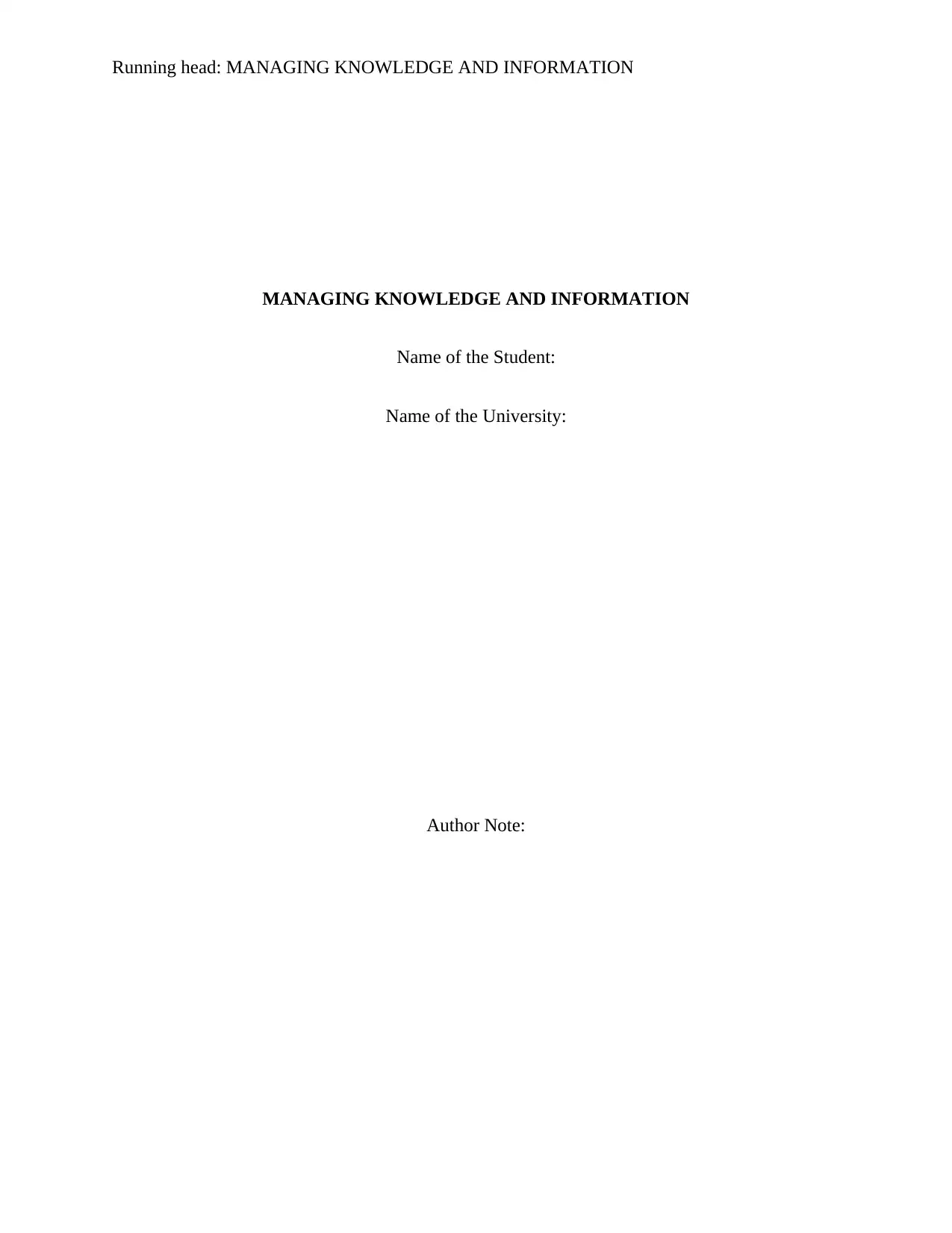
Running head: MANAGING KNOWLEDGE AND INFORMATION
MANAGING KNOWLEDGE AND INFORMATION
Name of the Student:
Name of the University:
Author Note:
MANAGING KNOWLEDGE AND INFORMATION
Name of the Student:
Name of the University:
Author Note:
Paraphrase This Document
Need a fresh take? Get an instant paraphrase of this document with our AI Paraphraser
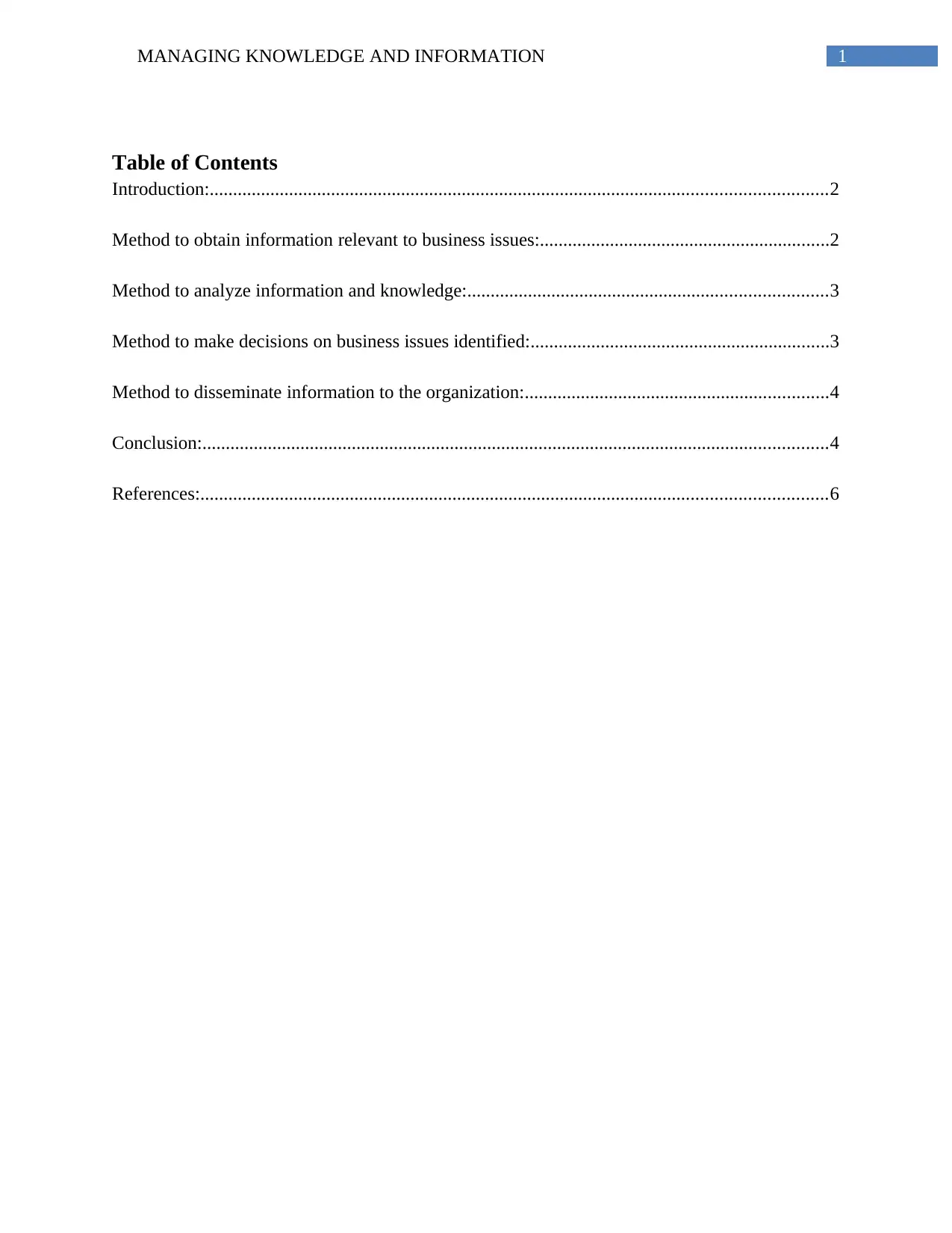
1MANAGING KNOWLEDGE AND INFORMATION
Table of Contents
Introduction:....................................................................................................................................2
Method to obtain information relevant to business issues:..............................................................2
Method to analyze information and knowledge:.............................................................................3
Method to make decisions on business issues identified:................................................................3
Method to disseminate information to the organization:.................................................................4
Conclusion:......................................................................................................................................4
References:......................................................................................................................................6
Table of Contents
Introduction:....................................................................................................................................2
Method to obtain information relevant to business issues:..............................................................2
Method to analyze information and knowledge:.............................................................................3
Method to make decisions on business issues identified:................................................................3
Method to disseminate information to the organization:.................................................................4
Conclusion:......................................................................................................................................4
References:......................................................................................................................................6
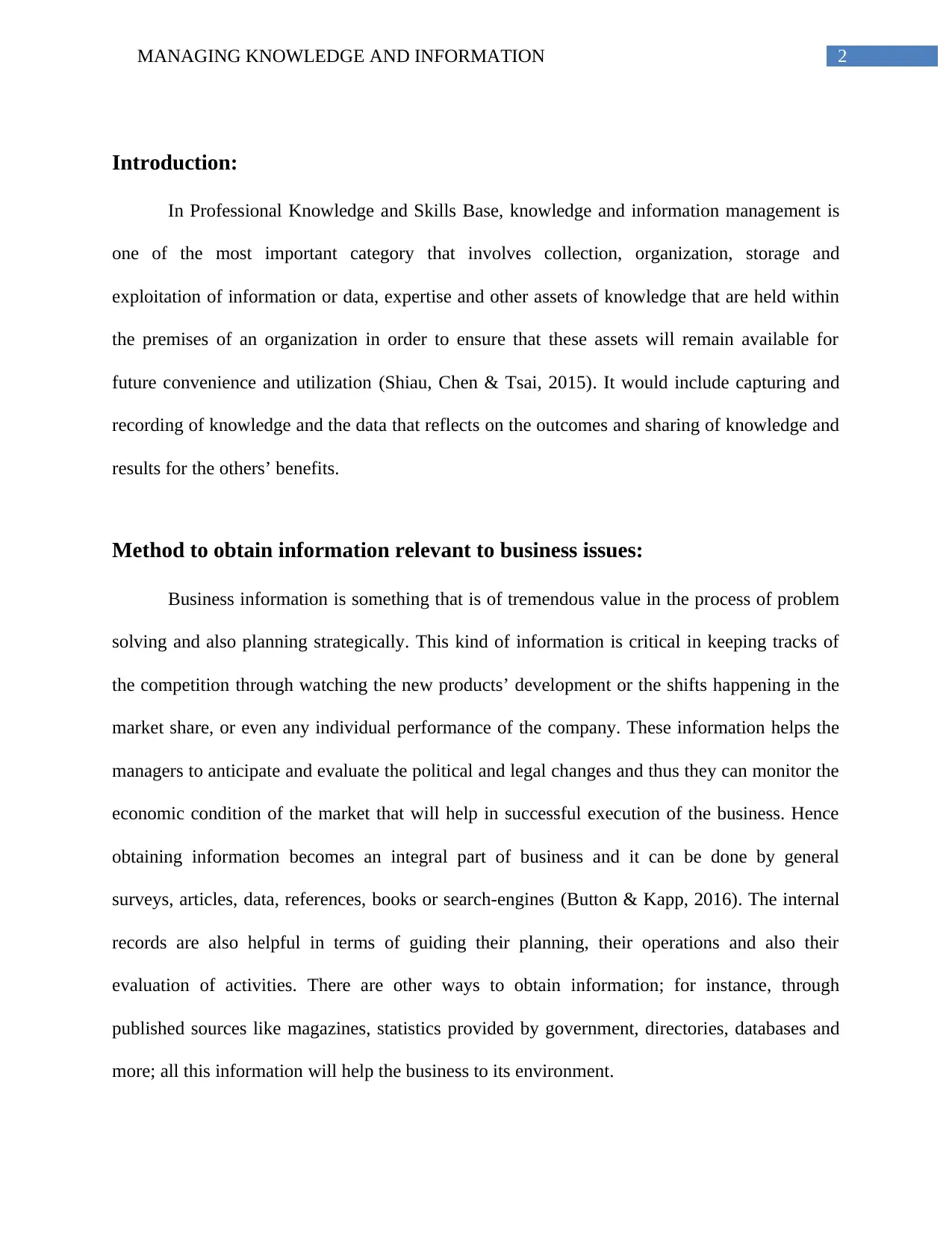
2MANAGING KNOWLEDGE AND INFORMATION
Introduction:
In Professional Knowledge and Skills Base, knowledge and information management is
one of the most important category that involves collection, organization, storage and
exploitation of information or data, expertise and other assets of knowledge that are held within
the premises of an organization in order to ensure that these assets will remain available for
future convenience and utilization (Shiau, Chen & Tsai, 2015). It would include capturing and
recording of knowledge and the data that reflects on the outcomes and sharing of knowledge and
results for the others’ benefits.
Method to obtain information relevant to business issues:
Business information is something that is of tremendous value in the process of problem
solving and also planning strategically. This kind of information is critical in keeping tracks of
the competition through watching the new products’ development or the shifts happening in the
market share, or even any individual performance of the company. These information helps the
managers to anticipate and evaluate the political and legal changes and thus they can monitor the
economic condition of the market that will help in successful execution of the business. Hence
obtaining information becomes an integral part of business and it can be done by general
surveys, articles, data, references, books or search-engines (Button & Kapp, 2016). The internal
records are also helpful in terms of guiding their planning, their operations and also their
evaluation of activities. There are other ways to obtain information; for instance, through
published sources like magazines, statistics provided by government, directories, databases and
more; all this information will help the business to its environment.
Introduction:
In Professional Knowledge and Skills Base, knowledge and information management is
one of the most important category that involves collection, organization, storage and
exploitation of information or data, expertise and other assets of knowledge that are held within
the premises of an organization in order to ensure that these assets will remain available for
future convenience and utilization (Shiau, Chen & Tsai, 2015). It would include capturing and
recording of knowledge and the data that reflects on the outcomes and sharing of knowledge and
results for the others’ benefits.
Method to obtain information relevant to business issues:
Business information is something that is of tremendous value in the process of problem
solving and also planning strategically. This kind of information is critical in keeping tracks of
the competition through watching the new products’ development or the shifts happening in the
market share, or even any individual performance of the company. These information helps the
managers to anticipate and evaluate the political and legal changes and thus they can monitor the
economic condition of the market that will help in successful execution of the business. Hence
obtaining information becomes an integral part of business and it can be done by general
surveys, articles, data, references, books or search-engines (Button & Kapp, 2016). The internal
records are also helpful in terms of guiding their planning, their operations and also their
evaluation of activities. There are other ways to obtain information; for instance, through
published sources like magazines, statistics provided by government, directories, databases and
more; all this information will help the business to its environment.
⊘ This is a preview!⊘
Do you want full access?
Subscribe today to unlock all pages.

Trusted by 1+ million students worldwide
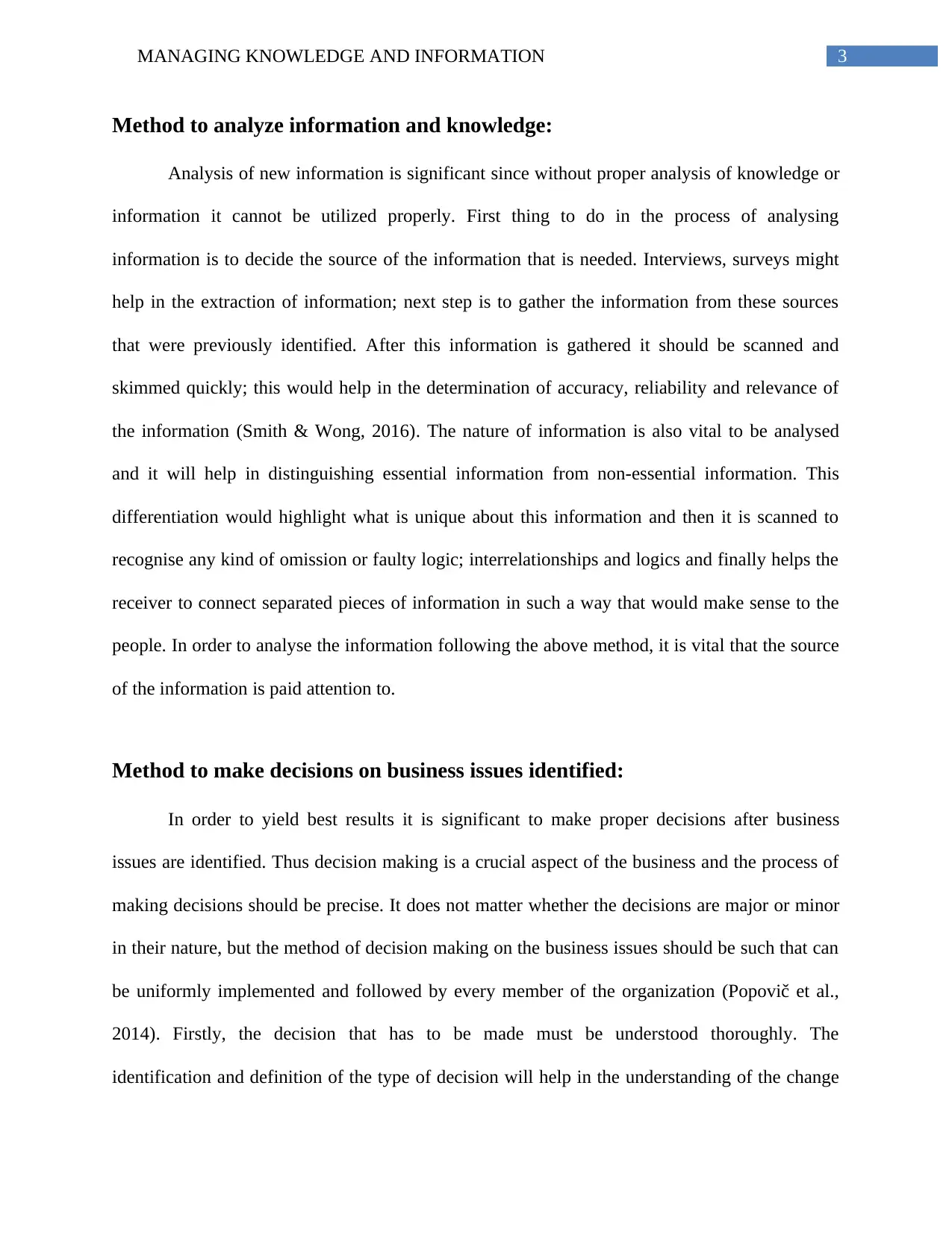
3MANAGING KNOWLEDGE AND INFORMATION
Method to analyze information and knowledge:
Analysis of new information is significant since without proper analysis of knowledge or
information it cannot be utilized properly. First thing to do in the process of analysing
information is to decide the source of the information that is needed. Interviews, surveys might
help in the extraction of information; next step is to gather the information from these sources
that were previously identified. After this information is gathered it should be scanned and
skimmed quickly; this would help in the determination of accuracy, reliability and relevance of
the information (Smith & Wong, 2016). The nature of information is also vital to be analysed
and it will help in distinguishing essential information from non-essential information. This
differentiation would highlight what is unique about this information and then it is scanned to
recognise any kind of omission or faulty logic; interrelationships and logics and finally helps the
receiver to connect separated pieces of information in such a way that would make sense to the
people. In order to analyse the information following the above method, it is vital that the source
of the information is paid attention to.
Method to make decisions on business issues identified:
In order to yield best results it is significant to make proper decisions after business
issues are identified. Thus decision making is a crucial aspect of the business and the process of
making decisions should be precise. It does not matter whether the decisions are major or minor
in their nature, but the method of decision making on the business issues should be such that can
be uniformly implemented and followed by every member of the organization (Popovič et al.,
2014). Firstly, the decision that has to be made must be understood thoroughly. The
identification and definition of the type of decision will help in the understanding of the change
Method to analyze information and knowledge:
Analysis of new information is significant since without proper analysis of knowledge or
information it cannot be utilized properly. First thing to do in the process of analysing
information is to decide the source of the information that is needed. Interviews, surveys might
help in the extraction of information; next step is to gather the information from these sources
that were previously identified. After this information is gathered it should be scanned and
skimmed quickly; this would help in the determination of accuracy, reliability and relevance of
the information (Smith & Wong, 2016). The nature of information is also vital to be analysed
and it will help in distinguishing essential information from non-essential information. This
differentiation would highlight what is unique about this information and then it is scanned to
recognise any kind of omission or faulty logic; interrelationships and logics and finally helps the
receiver to connect separated pieces of information in such a way that would make sense to the
people. In order to analyse the information following the above method, it is vital that the source
of the information is paid attention to.
Method to make decisions on business issues identified:
In order to yield best results it is significant to make proper decisions after business
issues are identified. Thus decision making is a crucial aspect of the business and the process of
making decisions should be precise. It does not matter whether the decisions are major or minor
in their nature, but the method of decision making on the business issues should be such that can
be uniformly implemented and followed by every member of the organization (Popovič et al.,
2014). Firstly, the decision that has to be made must be understood thoroughly. The
identification and definition of the type of decision will help in the understanding of the change
Paraphrase This Document
Need a fresh take? Get an instant paraphrase of this document with our AI Paraphraser
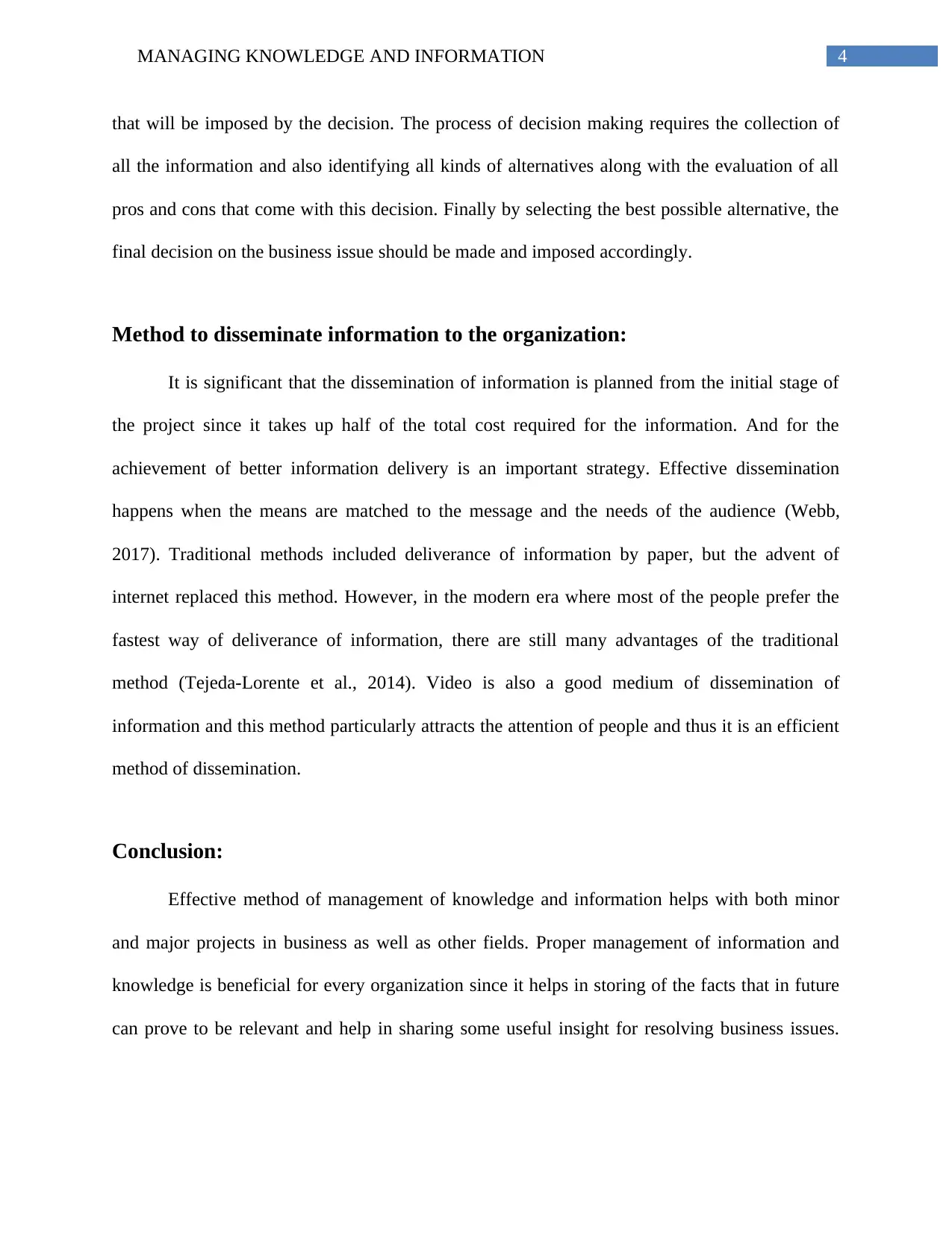
4MANAGING KNOWLEDGE AND INFORMATION
that will be imposed by the decision. The process of decision making requires the collection of
all the information and also identifying all kinds of alternatives along with the evaluation of all
pros and cons that come with this decision. Finally by selecting the best possible alternative, the
final decision on the business issue should be made and imposed accordingly.
Method to disseminate information to the organization:
It is significant that the dissemination of information is planned from the initial stage of
the project since it takes up half of the total cost required for the information. And for the
achievement of better information delivery is an important strategy. Effective dissemination
happens when the means are matched to the message and the needs of the audience (Webb,
2017). Traditional methods included deliverance of information by paper, but the advent of
internet replaced this method. However, in the modern era where most of the people prefer the
fastest way of deliverance of information, there are still many advantages of the traditional
method (Tejeda-Lorente et al., 2014). Video is also a good medium of dissemination of
information and this method particularly attracts the attention of people and thus it is an efficient
method of dissemination.
Conclusion:
Effective method of management of knowledge and information helps with both minor
and major projects in business as well as other fields. Proper management of information and
knowledge is beneficial for every organization since it helps in storing of the facts that in future
can prove to be relevant and help in sharing some useful insight for resolving business issues.
that will be imposed by the decision. The process of decision making requires the collection of
all the information and also identifying all kinds of alternatives along with the evaluation of all
pros and cons that come with this decision. Finally by selecting the best possible alternative, the
final decision on the business issue should be made and imposed accordingly.
Method to disseminate information to the organization:
It is significant that the dissemination of information is planned from the initial stage of
the project since it takes up half of the total cost required for the information. And for the
achievement of better information delivery is an important strategy. Effective dissemination
happens when the means are matched to the message and the needs of the audience (Webb,
2017). Traditional methods included deliverance of information by paper, but the advent of
internet replaced this method. However, in the modern era where most of the people prefer the
fastest way of deliverance of information, there are still many advantages of the traditional
method (Tejeda-Lorente et al., 2014). Video is also a good medium of dissemination of
information and this method particularly attracts the attention of people and thus it is an efficient
method of dissemination.
Conclusion:
Effective method of management of knowledge and information helps with both minor
and major projects in business as well as other fields. Proper management of information and
knowledge is beneficial for every organization since it helps in storing of the facts that in future
can prove to be relevant and help in sharing some useful insight for resolving business issues.
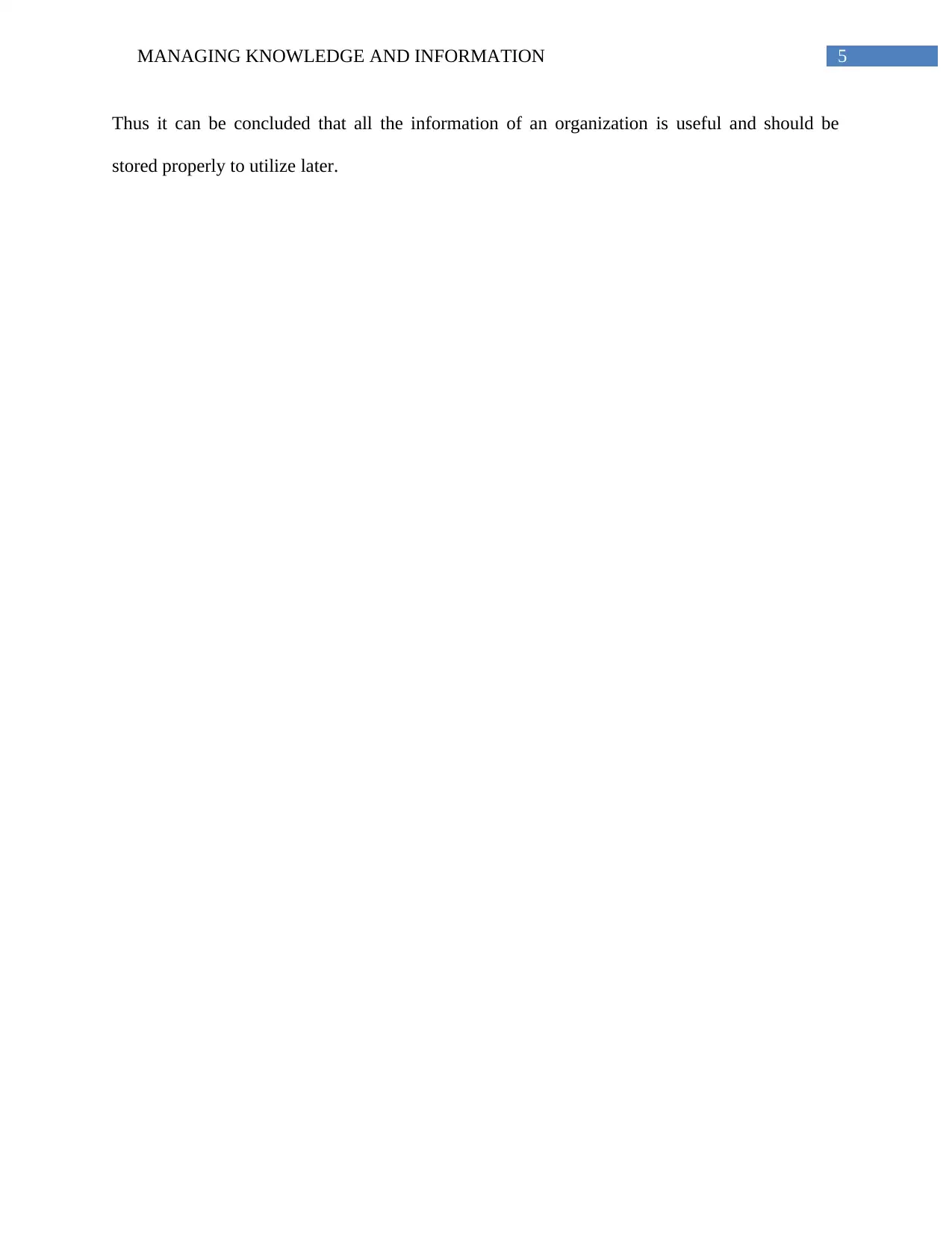
5MANAGING KNOWLEDGE AND INFORMATION
Thus it can be concluded that all the information of an organization is useful and should be
stored properly to utilize later.
Thus it can be concluded that all the information of an organization is useful and should be
stored properly to utilize later.
⊘ This is a preview!⊘
Do you want full access?
Subscribe today to unlock all pages.

Trusted by 1+ million students worldwide
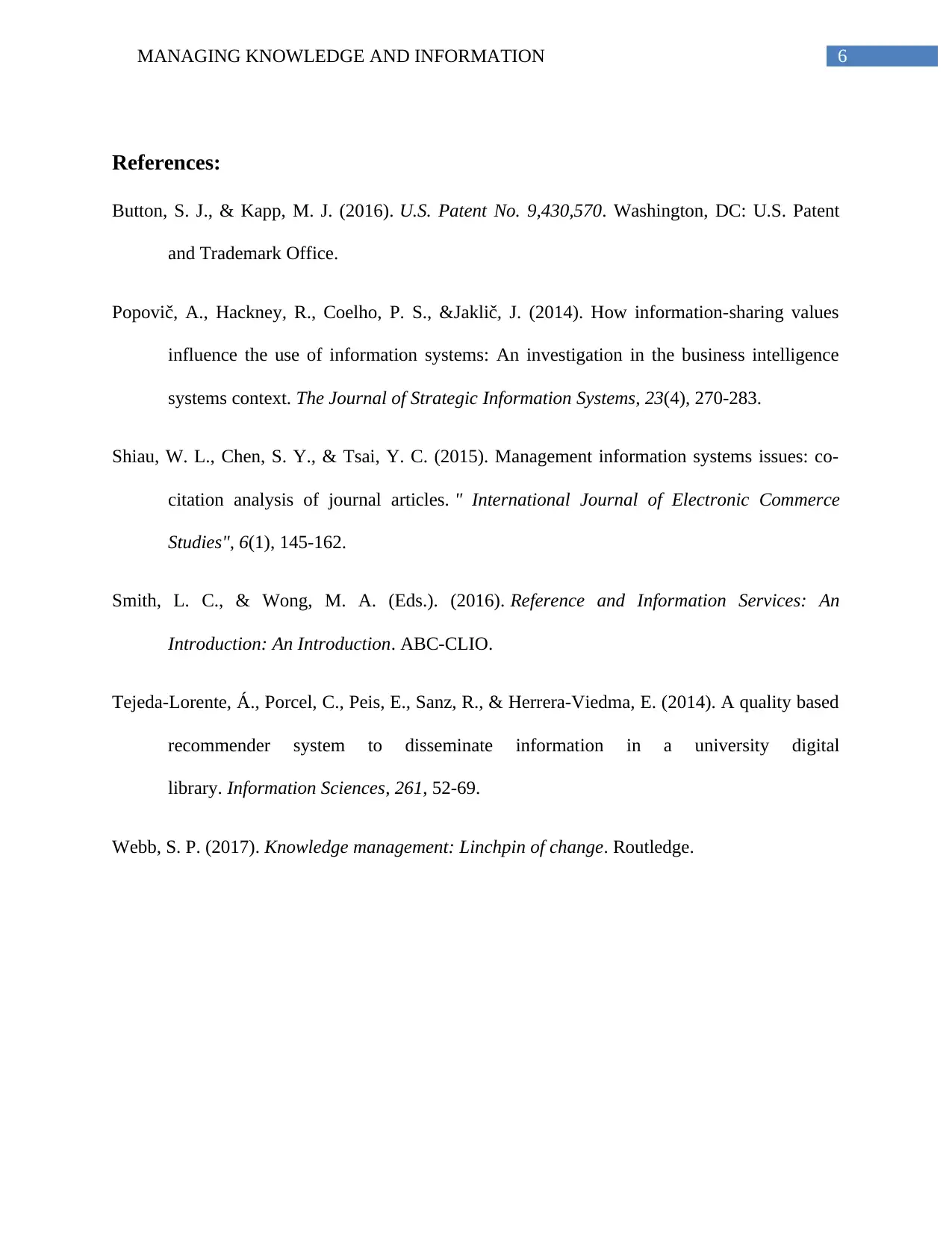
6MANAGING KNOWLEDGE AND INFORMATION
References:
Button, S. J., & Kapp, M. J. (2016). U.S. Patent No. 9,430,570. Washington, DC: U.S. Patent
and Trademark Office.
Popovič, A., Hackney, R., Coelho, P. S., &Jaklič, J. (2014). How information-sharing values
influence the use of information systems: An investigation in the business intelligence
systems context. The Journal of Strategic Information Systems, 23(4), 270-283.
Shiau, W. L., Chen, S. Y., & Tsai, Y. C. (2015). Management information systems issues: co-
citation analysis of journal articles. " International Journal of Electronic Commerce
Studies", 6(1), 145-162.
Smith, L. C., & Wong, M. A. (Eds.). (2016). Reference and Information Services: An
Introduction: An Introduction. ABC-CLIO.
Tejeda-Lorente, Á., Porcel, C., Peis, E., Sanz, R., & Herrera-Viedma, E. (2014). A quality based
recommender system to disseminate information in a university digital
library. Information Sciences, 261, 52-69.
Webb, S. P. (2017). Knowledge management: Linchpin of change. Routledge.
References:
Button, S. J., & Kapp, M. J. (2016). U.S. Patent No. 9,430,570. Washington, DC: U.S. Patent
and Trademark Office.
Popovič, A., Hackney, R., Coelho, P. S., &Jaklič, J. (2014). How information-sharing values
influence the use of information systems: An investigation in the business intelligence
systems context. The Journal of Strategic Information Systems, 23(4), 270-283.
Shiau, W. L., Chen, S. Y., & Tsai, Y. C. (2015). Management information systems issues: co-
citation analysis of journal articles. " International Journal of Electronic Commerce
Studies", 6(1), 145-162.
Smith, L. C., & Wong, M. A. (Eds.). (2016). Reference and Information Services: An
Introduction: An Introduction. ABC-CLIO.
Tejeda-Lorente, Á., Porcel, C., Peis, E., Sanz, R., & Herrera-Viedma, E. (2014). A quality based
recommender system to disseminate information in a university digital
library. Information Sciences, 261, 52-69.
Webb, S. P. (2017). Knowledge management: Linchpin of change. Routledge.
1 out of 7
Related Documents
Your All-in-One AI-Powered Toolkit for Academic Success.
+13062052269
info@desklib.com
Available 24*7 on WhatsApp / Email
![[object Object]](/_next/static/media/star-bottom.7253800d.svg)
Unlock your academic potential
Copyright © 2020–2025 A2Z Services. All Rights Reserved. Developed and managed by ZUCOL.





